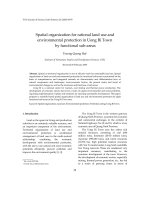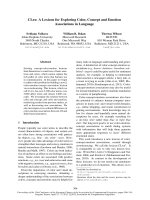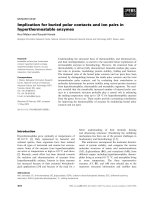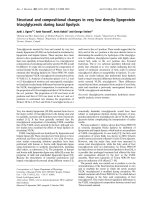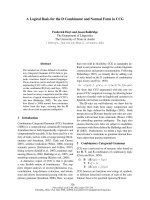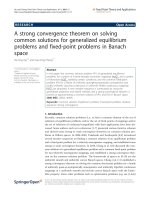Innovative solutions for minimizing differential deflection and heaving motion in very large floating structures
Bạn đang xem bản rút gọn của tài liệu. Xem và tải ngay bản đầy đủ của tài liệu tại đây (2.7 MB, 212 trang )
INNOVATIVE SOLUTIONS FOR MINIMIZING
DIFFERENTIAL DEFLECTION AND HEAVING MOTION
IN VERY LARGE FLOATING STRUCTURES
PHAM DUC CHUYEN
NATIONAL UNIVERSITY OF SINGAPORE
2009
INNOVATIVE SOLUTIONS FOR MINIMIZING
DIFFERENTIAL DEFLECTION AND HEAVING MOTION
IN VERY LARGE FLOATING STRUCTURES
PHAM DUC CHUYEN
B.Eng. (NUCE), M.Eng. (AIT)
A THESIS SUBMITTED
FOR THE DEGREE OF DOCTOR OF PHILOSOPHY
DEPARTMENT OF CIVIL ENGINEERING
NATIONAL UNIVERSITY OF SINGAPORE
2009
Acknowledgements
i
ACKNOWLEDGMENTS
First of all, my greatest thanks go to my supervisor Professor Wang Chien Ming, for
his education, ideas, inspiration, advises, prompt and clear comments about our work,
answers on many questions, and constant enthusiasm and interest. I consider myself as
a very happy person to work with such an outstanding researcher as a supervisor. And
I learned a lot about research, scientific philosophy and other things, for instance, how
to get joy from the equations and problems.
Next, I am grateful to my co-supervisor Professor Ang Kok Keng for his
valuable and useful discussions, information and comments through out the research. I
am also indeed grateful to Professor Tomoaki Utsunomiya from Kyoto University for
his advice and useful discussions on this research study.
I would also like to thank the chairman of my thesis advisory committee,
Professor Koh Chan Ghee for his valuable advice and suggestions on my research and
thesis. I am also thankful for the professors who examined my thesis. Their supportive
comments and suggestions were very much useful for the future improvement of the
thesis.
I’m grateful to the National University of Singapore for providing financial
support in the form of the NUS scholarship and facilities to carry out the research. The
Acknowledgements
ii
support provided by Mr. Krishna Sanmugam and technicians at Hydraulic Laboratory
in the use of equipments and computer facilities to carry out the experiment is also
appreciated.
In addition, I would like to extend my gratefulness to my colleagues in Civil
Engineering Department, especially Mr Tay Zhi Yung, Mr Muhammad Riyansyah, Ms
Bangun Emma Patricia, for their friendship, encouragement and valuable discussion
during the study.
Last but not least, I would like to express the deepest gratitude to my beloved
parents, wife and sisters for their eternal support, encouragement and love. I could not
finish the whole study without the great love and care from you.
iii
TABLE OF CONTENTS
Acknowledgements i
Table of Contents iii
Summary viii
List of Tables xi
List of Figures xii
Notations xix
Chapter 1 Introduction 1
1.1 Background information on VLFS 3
1.1.1 Types of VLFS 3
1.1.2 Advantages of VLFS 4
1.1.3 Applications of VLFS 5
1.1.4 VLFS components 12
1.2 Literature Survey 12
1.2.1 VLFS assumptions, shapes and models 13
1.2.2 VLFS and water interaction modeling 15
1.2.3 Minimizing differential deflection in VLFS 17
1.2.4 Minimizing motion in VLFS 18
1.3 Objectives and scope of study 21
1.4 Layout of thesis 22
Table of Contents
iv
Chapter 2 Minimizing Differential Deflection in Circular VLFS 25
2.1 Introduction 25
2.2 Problem definition 27
2.3 Basic assumptions and governing equations 29
2.4 Exact bending solutions and boundary conditions 31
2.4.1 VLFS regions without buoyancy force 31
2.4.2 VLFS regions with buoyancy force 32
2.4.3 Boundary and continuity conditions 33
2.5 Results and discussions on effectiveness of gill cells 34
2.5.1 Basic dimensions and properties of VLFS example, loading and
freeboard conditions 34
2.5.2 Verification of results of VLFS with gill cells 34
2.5.3 Effectiveness of gill cells in reducing the differential deflection and
stress-resultants 36
2.6 Optimal design/location of gill cells in circular VLFS 40
2.6.1 Case 1 – Varying loading magnitudes q
l
41
2.6.2 Case 2 – Varying loading radius r
0
43
2.6.3 Case 3 – Varying top and bottom plate thicknesses t 45
2.6.4 Case 1 – Varying freeboard h
f
47
2.7 Comparing the effectiveness of gill cells with stepped VLFS 48
2.7.1 Case 1 – Varying loading magnitudes q
l
49
2.7.2 Case 2 – Varying loading radius r
0
50
2.7.3 Case 3 – Varying top and bottom plate thicknesses t 51
2.8 Optimal design/location of gill cells in annular VLFS 52
Table of Contents
v
2.8.1 Dimensions, properties of annual VLFS and proposed gill cells
location 52
2.8.2 Optimization formulation 53
2.8.3 Optimization results 54
2.9 Concluding remarks 56
Chapter 3 Minimizing Differential Deflection in Non-circular Shaped VLFS
Using Gill Cells 58
3.1 Introduction 58
3.2 Problem definition 59
3.3 Basic assumptions and FEM model for VLFS bending analysis 61
3.4 Results and discussions on effectiveness of gill cells 64
3.4.1 Dimensions and properties of VLFS examples, loading and freeboard
conditions 64
3.4.2 Verification of results 64
3.4.3 Effect of gill cells in reducing the differential deflection and von Mises
stress 65
3.5 Optimization problem 67
3.6 Optimization results 72
3.6.1 Optimization results for square VLFS 72
3.6.2 Optimization results for rectangular VLFS 78
3.6.3 Optimization results for I-shaped VLFS 84
3.7 Concluding remarks 90
Table of Contents
vi
Chapter 4 Minimizing Heaving Motion of Circular VLFS using Submerged
Plate 91
4.1 Introduction 91
4.2 Problem definition 92
4.3 Basic assumptions, equations and boundary conditions for circular VLFS 93
4.4 Model expansion of motion 96
4.5 Solution for radiation potentials 99
4.6 Solution for diffraction potentials 113
4.7 Equation of motion in modal coordinate 114
4.8 Results and discussions 117
4.9 Concluding remarks 128
Chapter 5 Minimizing Heaving Motion of Longish VLFS Using Anti-Heaving
Devices 130
5.1 Introduction 130
5.2 Experimental facility and instrumentation 133
5.2.1 Wave tank 133
5.2.2 Wave generating system 135
5.2.3 Data acquisition system 135
5.2.4 Testing condition 138
5.2.5 VLFS model 138
5.2.6 Types of anti-heaving devices 140
5.3 Experimental procedure 142
5.4 Experimental results 143
5.4.1 VLFS with submerged horizontal plate 143
5.4.2 VLFS with vertical plate 147
Table of Contents
vii
5.4.3 VLFS with L-shaped plate 151
5.4.4 VLFS with inclined plate 155
5.5 Most effective anti-heaving device 158
5.6 Concluding remarks 165
Chapter 6 Conclusions and Recommendations for Future Work 167
6.1 Conclusions 168
6.2 Recommendations for future work 171
References 174
List of Publications 186
viii
SUMMARY
In the new millennium, the world is facing new problems such as the lack of land, due
to the growing population and fast urban developments. Many island countries and
countries with long coastline have applied the traditional land reclamation method to
create land from the sea in order to decrease the pressure on the heavily used land
space. In recent years, an attractive alternative to land reclamation has emerged – the
very large floating structures technology. Very large floating structures (VLFS) can
and are already being used for storage facilities, industrial space, bridges, ferry piers,
docks, rescue bases, airports, entertainment facilities, military purpose, and even
habitation. VLFSs can be speedily constructed, exploited, and easily relocated,
expanded, or removed. These structures are reliable, cost effective, and
environmentally friendly.
VLFS may undergo large differential deflection under heavy nonuniformly
distributed loads and large motion under strong wave action. These conditions may
affect the smooth operation of equipments, the structural integrity and even the safety
of people on VLFS. The main objectives of this study are to develop (1) innovative
solutions to minimize the differential deflection of VLFS and (2) innovative solutions
to minimize the heaving motion of VLFSs for various shapes and dimensions. Various
alternative solutions are treated.
For minimizing the differential deflection in unevenly loaded circular VLFS,
two solutions were proposed. One solution makes use of the so-called “gill cells” and
Summary
ix
the other solution involves stepped VLFS (i.e. VLFS with varying height). Gill cells
are compartments in VLFS with holes or slits at their bottom floor that allow water to
flow in and out freely. As a result, the buoyancy forces are eliminated at the VLFS
region with gill cells. By suitable positioning the gill cells, one can reduce the
differential deflection of VLFS significantly. Although the stepped VLFS solution
reduces the differential deflection, it is not as effective as using the gill cells.
Furthermore, by reducing the differential deflection, the stress-resultants and bending
stresses in the VLFS are correspondingly reduced. In this study, the gill cells have
been used to minimize the slope in an annular shaped VLFS. In the circular and
annular shaped VLFS, the analytical bending solutions based on the Kirchhoff
hypothesis for plate bending analysis and the classical Newton optimization method
were used to seek the optimal design of gill cells.
Further investigation on the use of gill cells for minimizing the differential
deflection of arbitrary non-circular VLFS were made. As analytical solutions for
bending analysis of arbitrarily shaped VLFS are not available, finite plate element
analysis based on the Mindlin plate theory was employed. The Mindlin plate theory
was adopted in order to provide better accuracy of the computed stress resultants as
well as to include the effect of transverse shear deformation. For the optimization of
the position of gill cells in an arbitrarily shaped VLFS under an arbitrary loading
condition, Genetic Algorithms were employed because of its robustness in getting the
global optimum solution and the method allows the natural switching on and off the
gill cells in the optimization search. The effective of gill cells in reducing differential
deflection and stress-resultants in VLFS was confirmed from the extensive numerical
computations and examples considered.
Summary
x
In the investigation of the second topic of this study, i.e. the development of
anti-motion devices for VLFS under wave action, the author first considers circular
VLFS attached with a submerged horizontal annular plate strip that goes around the
edge of VLFS. Exact analytical solutions of hydroelastic were derived by making use
of the exact circular and annular plate solutions and exact velocity potential solutions
for circular domains. The effectiveness of this anti-motion device is demonstrated by
performing the analysis and comparing the results with and without the submerged
annular plate strip.
Further studies were investigated on minimizing the heaving motion of
rectangular VLFS under the action of waves by using various anti-motion devices
attached to its fore-end. These anti-motion devices include submerged horizontal plate,
vertical plate, L-shaped plate, and inclined plate. The effectiveness of these anti-
motion devices is confirmed by experimental results. Among these devices, inclined
plate seems to be the most effective device and it is recommended to be used in
appropriate VLFS applications.
xi
LIST OF TABLES
Table 2.1 Effect of gill cells in reducing maximum differential deflection and
maximum stress-resultants 40
Table 2.2 Effectiveness of optimal gill cells in reducing the maximum slope and
maximum stresses-resultants 55
Table 5.1 Pertinent information of model 140
Table 5.2 Anti-heaving devices considered in the experiment 141
xii
LIST OF FIGURES
Fig. 1.1 Types of VLFS 3
Fig. 1.2 Mega-float in Tokyo Bay, Japan 6
Fig. 1.3 Floating Oil Storage Base at Kamigoto, Japan 6
Fig. 1.4 Yumeshima-Maishima Floating Bridge in Osaka, Japan 6
Fig. 1.5 Floating Rescue Emergency Base at Osaka Bay, Japan 6
Fig. 1.6 Floating island at Onomichi Hiroshima, Japan 6
Fig. 1.7 Floating pier at Ujina Port Hiroshima, Japan 6
Fig. 1.8 Floating Restaurant in Yokohoma, Japan 7
Fig. 1.9 Floating Performance Stage, Singapore 7
Fig. 1.10 Floating helicopter pad in Vancouver, Canada 7
Fig. 1.11 Kelowna floating bridge in British Columbia, Canada 7
Fig. 1.12 Bergsøysund floating bridge, Norway 7
Fig. 1.13 Nordhordland Bridge Floating Bridge, Norway 7
Fig. 1.14 Hood Canal Floating Bridge in Washington States, USA 8
Fig. 1.15 Dubai Floating Bridge in Dubai, United Arab Emirates 8
Fig. 1.16 Marine Uranus by Nishimatsu Corporation 11
Fig. 1.17 Pearl Shell by Shimizu Corporation 11
Fig. 1.18 Osaka Focus A by Japanese Society of Steel Construction 11
Fig. 1.19 Osaka Focus B by Japanese Society of Steel Construction 11
List of Figures
xiii
Fig. 1.20 Components of a pontoon-type VLFS 12
Fig. 2.1 Pontoon-type circular VLFS with gill cells and varying heights 28
Fig. 2.2 Pontoon-type ring-shaped VLFS 29
Fig. 2.3 Design mesh of circular VLFS with gill cells used in SAP2000 analysis 35
Fig. 2.4 Comparison deflections w between analytical solutions and SAP2000 result
of circular VLFS with gill cells 36
Fig. 2.5 Effect of gill cells on deflections w 38
Fig. 2.6 Effect of gill cells on shear force
r
Q 38
Fig. 2.7 Effect of gill cells on radial moment
r
M 39
Fig. 2.8 Effect of gill cells on circumferential moment
θ
M 39
Fig. 2.9 Optimal design of gill cells when varying q
l
42
Fig. 2.10 Effect of optimal gill cells when varying q
l
42
Fig. 2.11 Optimal design of gill cells when varying r
0
44
Fig. 2.12 Effect of optimal gill cells when varying r
0
45
Fig. 2.13 Optimal design of gill cells when varying t 46
Fig. 2.14 Effect of optimal gill cells when varying
t 46
Fig. 2.15 Optimal design of gill cells when varying freeboard
h
f
47
Fig. 2.16 Effect of optimal gill cells when varying freeboard h
f
48
Fig. 2.17 Effect of optimal gill cells and optimal stepped VLFS when varying
q
l
50
Fig. 2.18 Effect of optimal gill cells and optimal stepped VLFS when varying
r
0
51
Fig. 2.19 Effect of optimal gill cells and optimal stepped VLFS when varying t 52
Fig. 2.20 Annular VLFS with gill cells 53
Fig. 2.21 Effect of optimal gill cells on slope
dw
55
Fig. 3.1 Square, rectangular and I-shaped VLFSs 60
List of Figures
xiv
Fig. 3.2 Definitions of deflection and rotations 62
Fig. 3.3 Nondimensionalized deflection contour
w
in a quarter of the square VLFS
without gill cells 66
Fig. 3.4 Nondimensionalized deflection contour w in a quarter of the square VLFS
with gill cells 67
Fig. 3.5 Transformation of binary string to a quarter of the square VLFS with gill cells
(shaded cells) in genetic algorithms rubric 70
Fig. 3.6 Optimization program flow-chart integrating GA and developed FEM
model 72
Fig. 3.7 Stage 1 for a quarter of square VLFS 73
Fig. 3.8 Layouts of gill cells in quadrant of square VLFS for various generations in
Stage 2 74
Fig. 3.9 Square VLFS with some possible optimal designs of gill cells 75
Fig. 3.10 Nondimensionalized deflection contour w of square VLFS 76
Fig. 3.11 Von Mises stress of a quarter of square VLFS 77
Fig. 3.12 Stage 1 for rectangular VLFS 79
Fig. 3.13 Layouts of gill cells in a quadrant of rectangular VLFS for various
generations in Stage 2 79
Fig. 3.14 Rectangular VLFS with some possible optimal designs of gill cells 81
Fig. 3.15 Nondimensionalized deflection contour
w in the rectangular VLFS 82
Fig. 3.16 Von Mises stress of a quarter of rectangular VLFS 83
Fig. 3.17 Stage 1 for I-shaped VLFS 84
Fig. 3.18 Layouts of gill cells in quadrant of I-shaped VLFS for various generations in
Stage 2 85
Fig. 3.19 I-shaped VLFS with some possible optimal designs of gill cells 87
Fig. 3.20 Nondimesionalized deflection contour
w in I-shaped VLFS 88
Fig. 3.21 Von Mises stress of a quarter of the I-shaped VLFS 89
Fig. 4.1 Geometry of uniform circular VLFS and coordinate system 93
List of Figures
xv
Fig. 4.2 Nondimensionalized deflection amplitude for circular VLFS with 2m width
submerged plate 119
Fig. 4.3 Nondimensionalized deflection amplitude for circular VLFS with 10m width
submerged plate 119
Fig. 4.4 Nondimensionalized deflection amplitude of VLFS without and with
submerged plate of various widths 120
Fig. 4.5 Nondimensionalized bending moment amplitude of VLFS without and with
submerged plate of various widths 120
Fig. 4.6 Nondimensionalized twisting moment amplitude of VLFS without and with
submerged plate of various widths 121
Fig. 4.7 Nondimensionalized transverse shear force amplitude of VLFS without and
with submerged plate of various widths 121
Fig. 4.8 Nondimensionalized deflection amplitude for circular VLFS with 8m width
submerged plate at level d = 2m 123
Fig. 4.9 Nondimensionalized deflection amplitude for circular VLFS with 8m width
submerged plate at level d = 19.5m 123
Fig. 4.10 Nondimensionalized deflection amplitude of VLFS without and with
submerged plate at various depths 124
Fig. 4.11 Nondimensionalized bending moment amplitude of VLFS without and with
submerged plate at various depths 124
Fig. 4.12 Nondimensionalized twisting moment amplitude of VLFS without and with
submerged plate at various depths 125
Fig. 4.13 Nondimensionalized shear force amplitude of VLFS without and with
submerged plate at various depths 125
Fig. 4.14 Nondimensionalized deflection amplitude for basic circular VLFS at fore-
end 126
Fig. 4.15 Nondimensionalized deflection amplitude for circular VLFS with submerged
plate at fore-end 127
Fig. 4.16 Nondimensionalized deflection amplitude of VLFS at fore-end 127
Fig. 4.17 Nondimensionalized deflection amplitude of VLFS at mid-position 128
Fig. 4.18 Nondimensionalized deflection amplitude of VLFS at back-end 128
Fig. 5.1 VLFS with box-shaped anti-motion device 130
List of Figures
xvi
Fig. 5.2 VLFS with submerged vertical plate anti-motion device 131
Fig. 5.3 VLFS with anti-motion devices treated by Ohta et al. (2002) 132
Fig. 5.4 Wave tank in Hydraulic Engineering Laboratory, NUS 133
Fig. 5.5 Experimental setup 134
Fig. 5.6 Wave generating system controller 136
Fig. 5.7 Wave data acquisition system 137
Fig. 5.8 Deflection data acquisition system 137
Fig. 5.9 Experimental model placed in wave tank 139
Fig. 5.10 Simple bending test to determine flexural rigidity EI of VLFS model 140
Fig. 5.11 Nondimensionalized deflection amplitude of VLFS without and with
horizontal plate at wave period 0.8s 144
Fig. 5.12 Nondimensionalized deflection amplitude of VLFS without and with
horizontal plate at wave period 0.9s 145
Fig. 5.13 Nondimensionalized deflection amplitude of VLFS without and with
horizontal plate at wave period 1s 145
Fig. 5.14 Nondimensionalized deflection amplitude of VLFS without and with
horizontal plate at wave period 1.1s 146
Fig. 5.15 Nondimensionalized deflection amplitude of VLFS without and with
horizontal plate at wave period 1.2s 146
Fig. 5.16 Nondimensionalized deflection amplitude of VLFS without and with
horizontal plate at wave period 1.3s 147
Fig. 5.17 Nondimensionalized deflection amplitude of VLFS without and with vertical
plate at wave period 0.8s 148
Fig. 5.18 Nondimensionalized deflection amplitude of VLFS without and with vertical
plate at wave period 0.9s 148
Fig. 5.19 Nondimensionalized deflection amplitude of VLFS without and with vertical
plate at wave period 1s 149
Fig. 5.20 Nondimensionalized deflection amplitude of VLFS without and with vertical
plate at wave period 1.1s 149
Fig. 5.21 Nondimensionalized deflection amplitude of VLFS without and with vertical
plate at wave period 1.2s 150
List of Figures
xvii
Fig. 5.22 Nondimensionalized deflection amplitude of VLFS without and with vertical
plate at wave period 1.3s 150
Fig. 5.23 Nondimensionalized deflection amplitude of VLFS without and with L-
shaped plate at wave period 0.8s 152
Fig. 5.24 Nondimensionalized deflection amplitude of VLFS without and with L-
shaped plate at wave period 0.9s 152
Fig. 5.25 Nondimensionalized deflection amplitude of VLFS without and with L-
shaped plate at wave period 1s 153
Fig. 5.26 Nondimensionalized deflection amplitude of VLFS without and with L-
shaped plate at wave period 1.1s 153
Fig. 5.27 Nondimensionalized deflection amplitude of VLFS without and with L-
shaped plate at wave period 1.2s 154
Fig. 5.28 Nondimensionalized deflection amplitude of VLFS without and with L-
shaped plate at wave period 1.3s 154
Fig. 5.29 Nondimensionalized deflection amplitude of VLFS without and with inclined
plate at wave period 0.8s 155
Fig. 5.30 Nondimensionalized deflection amplitude of VLFS without and with inclined
plate at wave period 0.9s 156
Fig. 5.31 Nondimensionalized deflection amplitude of VLFS without and with inclined
plate at wave period 1s 156
Fig. 5.32 Nondimensionalized deflection amplitude of VLFS without and with inclined
plate at wave period 1.1s 157
Fig. 5.33 Nondimensionalized deflection amplitude of VLFS without and with inclined
plate at wave period 1.2s 157
Fig. 5.34 Nondimensionalized deflection amplitude of VLFS without and with inclined
plate at wave period 1.3s 158
Fig. 5.35 Nondimensionalized deflection amplitude of VLFS without and with anti-
heaving device of 20cm length at wave period 0.8s 159
Fig. 5.36 Nondimensionalized deflection amplitude of VLFS without and with anti-
heaving device of 20cm length at wave period 0.9s 159
Fig. 5.37 Nondimensionalized deflection amplitude of VLFS without and with anti-
heaving device of 20cm length at wave period 1s 160
List of Figures
xviii
Fig. 5.38 Nondimensionalized deflection amplitude of VLFS without and with anti-
heaving device of 20cm length at wave period 1.1s 160
Fig. 5.39 Nondimensionalized deflection amplitude of VLFS without and with anti-
heaving device of 20cm length at wave period 1.2s 161
Fig. 5.40 Nondimensionalized deflection amplitude of VLFS without and with anti-
heaving device of 20cm length at wave period 1.3s 161
Fig. 5.41 Nondimensionalized deflection amplitude of VLFS without and with anti-
heaving device of 10cm length at wave period 0.8s 162
Fig. 5.42 Nondimensionalized deflection amplitude of VLFS without and with anti-
heaving device of 10cm length at wave period 0.9s 163
Fig. 5.43 Nondimensionalized deflection amplitude of VLFS without and with anti-
heaving device of 10cm length at wave period 1s 163
Fig. 5.44 Nondimensionalized deflection amplitude of VLFS without and with anti-
heaving device of 10cm length at wave period 1.1s 164
Fig. 5.45 Nondimensionalized deflection amplitude of VLFS without and with anti-
heaving device of 10cm length at wave period 1.2s 164
Fig. 5.46 Nondimensionalized deflection amplitude of VLFS without and with anti-
heaving device of 10cm length at wave period 1.3s 165
Notations
xix
NOTATIONS
A amplitude of incident wave (m)
a half width of annual submerged horizontal plate, length of cantilever test (m)
B horizontal dimension of anti-heaving device
b half length of VLFS testing model
B
χ
curvature-displacement matrix
B
γ
shear strain displacement matrix
D flexural rigidity of VLFS (kNm)
d distance from sea-bed to submerged horizontal plate (m)
D
b
bending stiffness matrix
D
S
shear stiffness matrix
dw
dx
slope in annular VLFS
max
dw
dx
maximum slope in annular VLFS with gill cells
0
dw
dx
maximum slope in annular VLFS without gill cells
E Young modulus of material (kN/m
2
)
E
m
equivalent Young modulus of VLFS (kN/m
2
)
F
i
force matrix
G shear modulus (kN/m
2
)
Notations
xx
g gravitational acceleration (m/s
2
)
H
water depth (m)
h overall depth of VLFS (m)
h
f
freeboard at the edge of VLFS (m)
h
1
larger depth of stepped VLFS (m)
h
2
smaller depth of stepped VLFS (m)
()
2
()
n
H • Hankel function of the second-kind
i imaginary unit i
2
= -1
)(
•
n
I modified first kind Bessel function
)(
•
n
J first kind Bessel function
K stiffness matrix
k wave number
6/5
=
s
K shear correction factor for the Mindlin plate
()
n
K • modified second-kind Bessel function
k
w
Winkler spring constant (kN/m
3
)
M
r
radial bending moment (kNm)
M
θ
twisting moment (kNm)
()
rr
M
MRD= non-dimensional bending moment
()
M
MRD
θθ
= non-dimensional twisting moment
M
rmax
maximum radial bending moment in VLFS with gill cells (kNm)
M
θmax
maximum twisting moment in VLFS with gill cells (kNm)
M
r0
maximum radial bending moment in VLFS (kNm)
M
θ0
maximum twisting moment in VLFS (kNm)
N
w
shape functions matrix
Notations
xxi
p total load acting on VLFS (kN/m
2
)
q
s
self weight of VLFS (kN/m
2
)
q
l
uniformly distributed loading magnitude acting on VLFS (kN/m
2
)
q
0
basic loading magnitudes acting on VLFS (kN/m
2
)
Q
r
shear force (kN)
()
2
rr
QQRD= non-dimensional shear force
Q
rmax
maximum shear force in VLFS with gill cells (kN)
Q
r0
maximum shear force in VLFS (kN)
R radius of circular VLFS, outer radius of annular VLFS (m)
r radial coordinate (m)
r
0
loading radius of circular VLFS, inner radius of annular VLFS (m)
r
1
inner radius of gill cells region in circular VLFS, inner radius of stepped region
in circular VLFS, inner radius of the first gill cells region in annular VLFS (m)
r
2
outer radius of gill cells region in circular VLFS, outer radius of stepped region
in circular VLFS, outer radius of the first gill cells region in annular VLFS (m)
r
3
inner radius of loading region in annular VLFS (m)
r
4
outer radius of loading region in annular VLFS (m)
r
5
inner radius of the second gill cells region in annular VLFS (m)
r
6
outer radius of the second gill cells region in annular VLFS (m)
S non-dimensional plate rigidity
s number of sequence for each mode
t top and bottom plate thickness of VLFS (m)
t
0
basic top and bottom plate thickness of VLFS (m)
w deflection of VLFS (m)
w displacement vector
w
e
deflection at the edge of VLFS (m)
Notations
xxii
w
c
deflection at the center of VLFS (m)
w
gm
maximum deflection in gill cells region (m)
w
ma
maximum deflection of VLFS (m)
w
mi
minimum deflection of VLFS (m)
/wwh= non-dimensional deflection
x horizontal coordinate (m)
()
n
Y • second kind Bessel function
z vertical coordinate (m)
21
hh
α
= step ratio
Γ truncation number
γ shear strain vector
γ
m
weight density of VLFS (kg/m
3
)
γ
w
weight density of water (kg/m
3
)
wΔ maximum differential deflection in VLFS with gill cells or stepped VLFS (m)
0
wΔ maximum differential deflection in VLFS (m)
()
∇• Laplacian operator
ε curvature strain vector
θ
circumferential coordinate (radian)
λ
wave length (m)
nj
λ
j
-th positive root of the equation
()
0
nnj
J
λ
=
υ
Poisson ratio
χ
non-dimensional radial coordinate = r/R
φ
velocity potential
ns
φ
radiation potential
Notations
xxiii
D
n
φ
diffraction potential
I
φ
velocity potential of the undisturbed incident wave
x
φ
rotation about the y axe
y
φ
rotation about the x axe
ϖ
wave frequency
